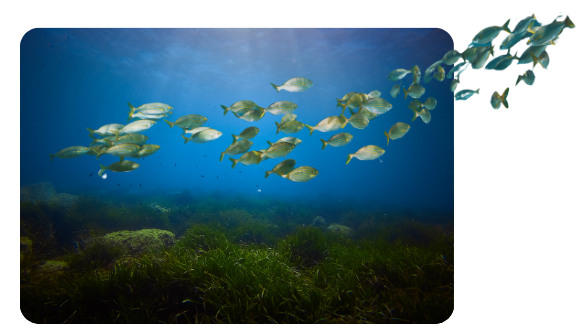Story
PML scientists contribute to international nitrogen impact guidance
31 October 2025
The International Nitrogen Management System (INMS) Guidance Document on Nitrogen Impact Assessment Methods provides a comprehensive framework and practical methodologies for assessing the environmental, agricultural and societal impacts of nitrogen at local, regional and global scales.

Eutrophication | Övergödslat Vatten CC BY-SA 4.0
Although nitrogen is vital for life on Earth, too much can lead to problems. The current levels of nitrogen input into the environment are putting health, climate, ecosystems and livelihoods at risk.
Sources of excess nitrogen in the environment can come from untreated sewage, fertilisers, fossil fuel combustion, agricultural practices and industrial processes. These elevated levels of nitrogen have been shown to alter the Earth’s natural nitrogen cycle, causing it to become a pollutant in many regions around the globe.
When nitrogen is mismanaged and becomes a pollutant, it contributes to climate change, air and water pollution, aquatic “dead zones,” and biodiversity loss. It also poses human health risks by causing respiratory issues and poisoning.
The International Nitrogen Management System (INMS) Guidance Document, published by the UK Centre for Ecology & Hydrology (UKCEH), serves as a foundational resource for policymakers, researchers and practitioners to help better understand and address the challenges of excess nitrogen.
The aim of this document is to help readers consider the nitrogen challenge in a global context, linking water, air, biodiversity, climate, health, food production and commerce. It helps explore sector-specific impacts, such as eutrophication, soil acidification, ozone damage to vegetation and human health risks from air and water pollution. It also emphasises the challenges of nitrogen overuse and underuse and links nitrogen impacts to their underlying mechanisms.
PML scientists played a key role in the development of this guidance document and were the lead-authors for the chapter ‘4.1.4. Nitrogen impacts on freshwater, coastal and marine fisheries’.
Dr Yuri Artioli, chapter co-lead and Marine Ecosystem Modeller at PML, said:
“This INMS guidance document emphasises the urgent need for international efforts to develop Nitrogen Action Plans, to meet the ambitious UN goal of reducing nitrogen waste and pollution by 2030. The importance of collaboration across sectors and nations to address the nitrogen challenge cannot be understated.”
“In our chapter, we highlight the complex, indirect and often masked impacts of excess nitrogen on fisheries. Overall, we found that even though moderate increases in reactive nitrogen can enhance primary productivity and prey availability in the short term, excessive nitrogen inputs can lead to oxygen depletion, habitat degradation and ultimately declines in fish stocks, which can cause economic losses in both wild fisheries and aquaculture”.
Key features of the Guidance Document:
- Comprehensive Framework: Introduces innovative models such as the “Pathways to Reactive Nitrogen Impacts” and the “Nitrogen Matrix of Impacts and Pressures (N-MIP)” to analyse nitrogen impacts using the Driver-Pressure-State-Impact-Response (DPSIR) framework.
- Integrated Methodologies: Provides advanced methods to help establish nitrogen budgets, nitrogen footprints, nitrogen use efficiency (NUE) assessments, planetary boundary approaches, critical loads, environmental performance index and cost-benefit analyses.
- Sector-Specific Assessments: Offers detailed methodologies for evaluating nitrogen impacts on aquatic and terrestrial ecosystems, greenhouse gas balance, agricultural production, human health, cultural services and non-agricultural nitrogen products.
- Policy Support: Includes practical tools for policymakers to evaluate trade-offs and pathways for sustainable nitrogen management.
- Global and Regional Case Studies: Features real-world examples from countries including Kenya, India, the Netherlands, Aotearoa New Zealand, Taiwan and the United States, showcasing how nitrogen impact assessments have informed policies and practices to reduce nitrogen pollution and improve environmental sustainability.
Other complementary INMS guidance documents focus on nitrogen flows and concentrations, nitrogen use efficiency, nitrogen budgets and mitigation methods.
Dr Jorn Bruggeman, chapter co-author and PML Fellow, commented:
“It is vital that we promote integrated approaches to reduce nitrogen waste, improve efficiency and mitigate its environmental impacts as a matter of urgency. By linking scientific methods with policy applications, the guidance serves as a critical resource for governments, researchers and policymakers to help address the global nitrogen challenge effectively”.
Prof. Icarus Allen, contributing author and Chief Executive of Plymouth Marine Laboratory, added:
“Nitrogen is both a cornerstone of life and a growing global challenge. While essential for food production and ecosystem function, its mismanagement threatens biodiversity, climate stability, and human health. The INMS guidance document provides a vital framework for understanding these complex dynamics—from agricultural efficiency to marine fisheries and air quality. Our work at PML highlights how excess nitrogen, though often invisible, can erode the foundations of sustainable development. Addressing this issue requires integrated science, informed policy, and international collaboration to secure a healthier, more resilient future.”
Related information
The International Nitrogen Management System (INMS) Guidance Document on Nitrogen Impact Assessment Methods
The International Nitrogen Management System (INMS)
INMS is a global science-support system for international nitrogen policy development established as a joint activity of the United Nations Environment Programme (UNEP) and the International Nitrogen Initiative (INI). It is supported with funding through the Global Environment Facility (GEF) and over 80 project partners through the ‘Towards INMS’ project (2017-2024).
